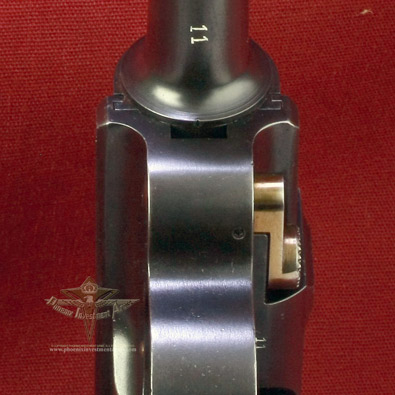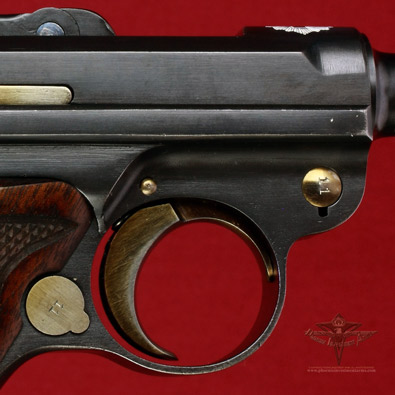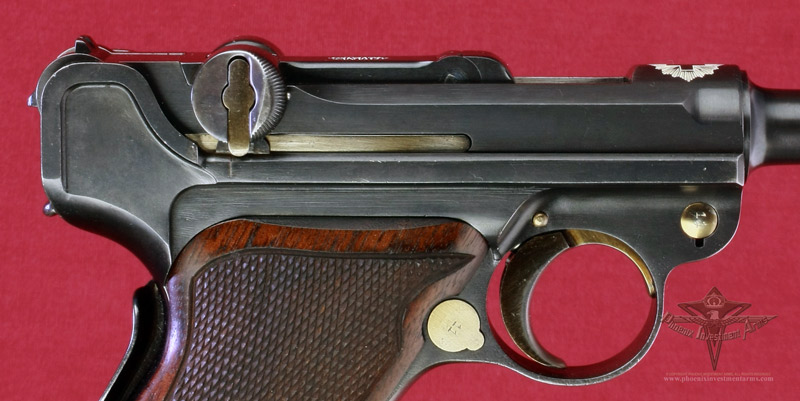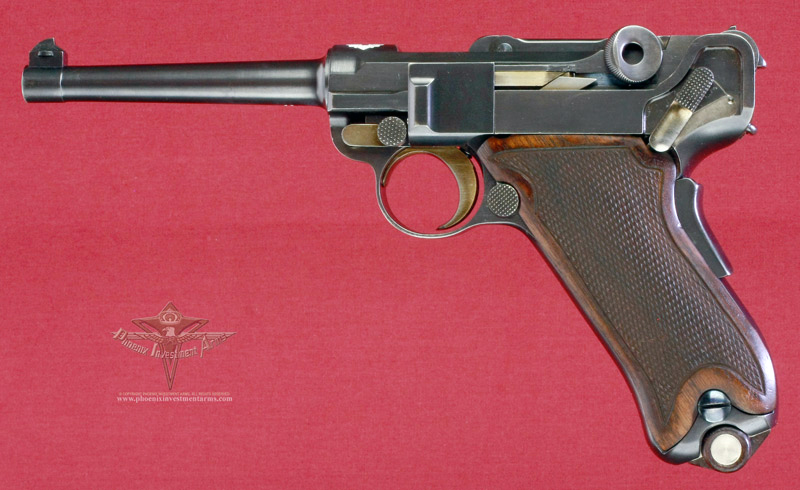
|
|
This is a 1898-99 Transitional Parabellum with a 175mm barrel, un-reinforced rear sight, hatched cut dished toggles, Type I thumb safety with many of the parts indicating this is a 1898 Transitional Pattern; no stock lug, unrelieved frame, square hinge profile on the 1st toggle link and cumulated with the intertwined GL on the rear toggle. This amazing, one of one, Transitional Parabellum created before the 1900 adoption by the Swiss. (1647) |
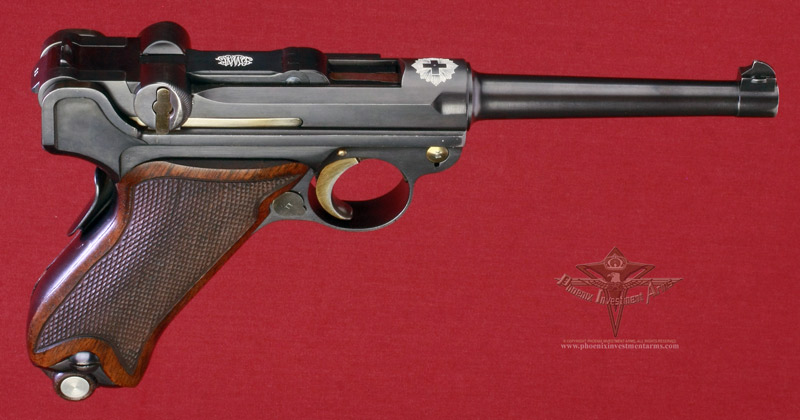
|
|
NOTE: Photographs taken today with the high mega-pixel camera show more than we sometimes can see with the human eye. Magnified close-ups show us tool marks and natural surface conditions that one normally doesn't see in the ordinary handling of the weapon. Photographs are copyrighted, all rights reserved, any extraction, reproduction or display of gun pictures without the express consent of the Phoenix Investment Arms is strictly prohibited. Thank you for your cooperation. Please visit Legal (tabbed) for Conditions of Sale. |
|
With the 1897 Swiss Trials of the C93 Borchardt not going well for the new company DWM (formed in late 1896) for unhandy size and weight plus the unwieldy shape of the Borchardt, Hugo Borchardt was presented the recommendations of the Swiss and turned them down. It then fell to Georg Luger to re-design this amazing "Winchester-Maxim" action into the world's most recognized handgun and he only had a few years to do this. Luger's "Neukonstruktion" was an intricate and often undocumented path of development, testing, modifications and more testing interwoven with a trail of patents as Luger sought to protect and sometime hide his latest designs. In April 1898 Luger had a wooden working model and in July 1888 a firing model was produced with the first testing in September 1888. So appeared the 55° grip with the internal return spring, the toggles directly at the central pivot point, the more balanced pistol we have come to know as the "Luger" in July 1898. |

|
|
|
Hidden away in a private collection for years this spectacular gun with the 175mm barrel ranks right up there with the "SP" 175mm barrel gun featured in Guns and Ammo and other early test and transitional Parabellums for uniqueness and rarity. |
|
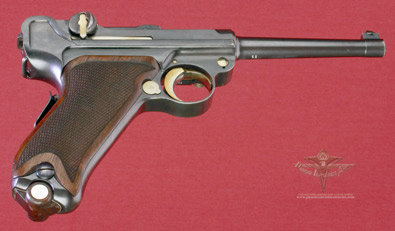
|
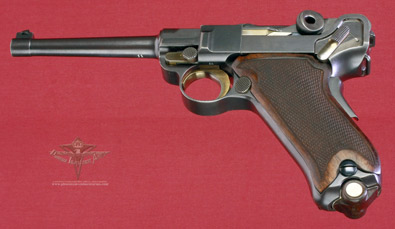
|

|
|
|
The barrel has the serial number perpendicular to the length, in 1898 numbering was not a prescribed manner for test guns and with the interchange of parts it was more designed to keep the gun parts together. The trigger guard is the wide 14.8mm. The magazine is unrelieved with a blank bottom. |
|
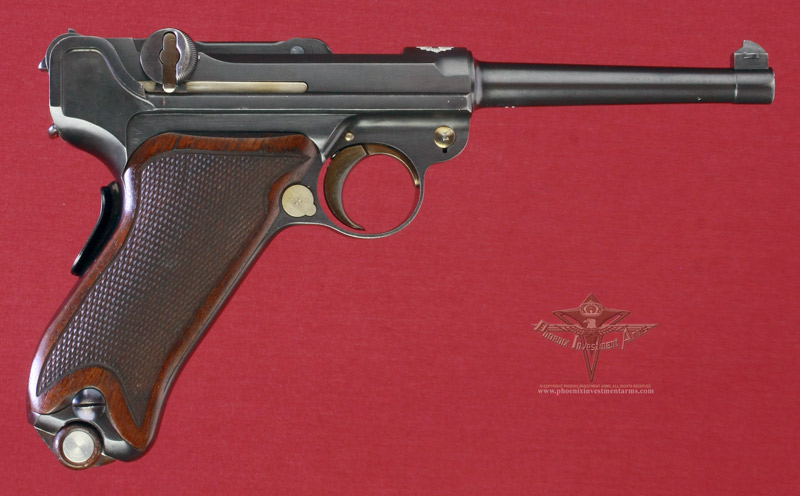
|
|
|
The Grips are an unusual pattern from the standard bordered grips of the Swiss Trials. Each set of grips was handmade and an obvious conclusion with the numbering and polish this Parabellum demonstrates, along with the GL icon, is that it was a presentation gun to someone after it served its purpose. |
|

|
|
These beginning pistols were iterative with changes being made per gun as it was produced; serial numbers were more purposely designed to identify parts with a given Parabellum, not sequentially track the guns. During the early development period new developments were made and guns were modified and tested. Parts replaced parts and there was no log or time line as the Parabellum developed from the bench to the firing line and back to the bench. What we do know from studying the existing models is that some of the characteristics of the 1898 Transition period and the 1899 pattern trials which led to the 1900 Production pattern can be traced through characteristics that were created, discarded and modified. |
|
|
|
| The top of the Parabellum is showing us the unmarked chamber which is typical of the early guns before the 1889 attributed characteristics or the pre-1899 Swiss Test Series and the 1900 series. |
|
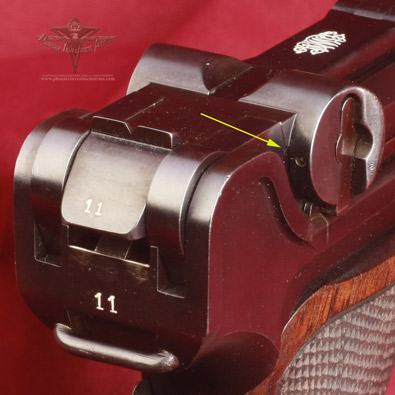
|
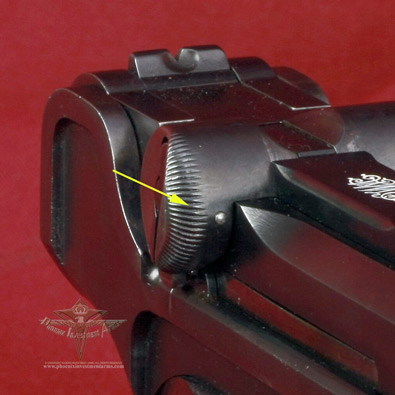
|
| Above Left: The dished toggles are smooth on the back side to act within the camming action of the raised ramps on the frame, assisting in the toggles "breaking" the action and starting the ejection phase of the firing sequence. |
|
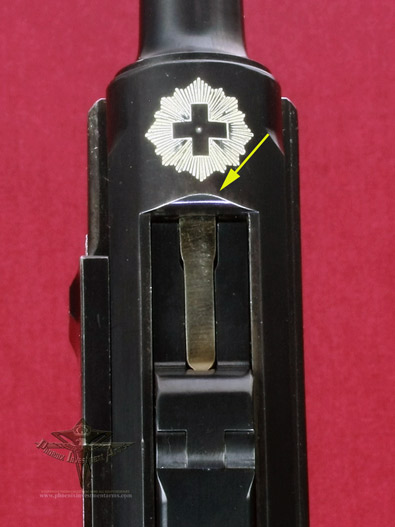 |
 |
Above Left: The front of the receiver show the slight curve of the 1889 test trials that was straightened in the 1900 Production gun. The blank first toggle link is without the DWM Logo but beveled on sides as a later characteristic of DWM. Somewhere around serial number 19 do the Swiss monogram and Geneva Cross proof marks begin to appear. Above Right: The right dished toggle with the toggle lock pinned through the side and the distinct very early dicing on the toggle. |
|
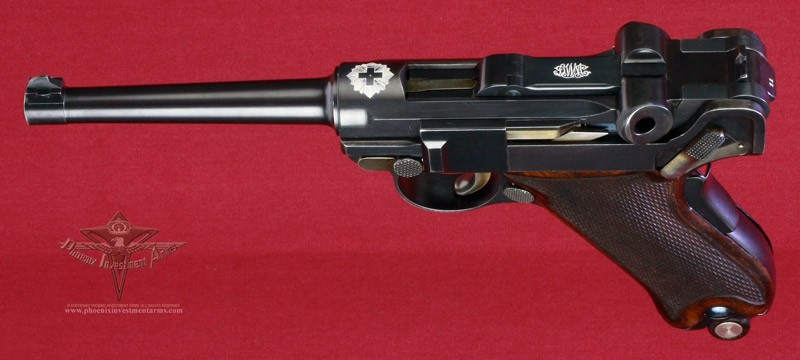 |
|
 |
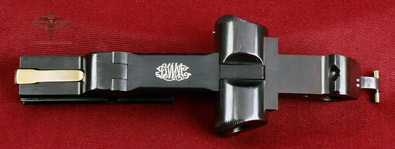 |
| The serial number is on the side of the 51mm breach block another characteristic of the 1898 models. Above Right the serial number 8 is on the top of the square toggle link and then appears on the underside of the 2nd toggle. | |
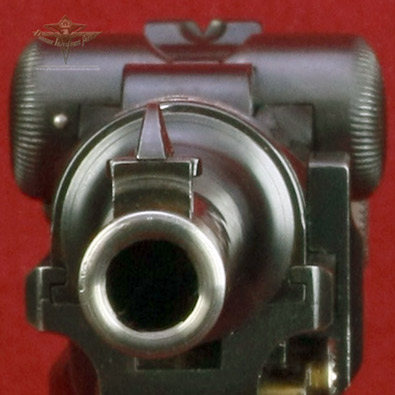 |
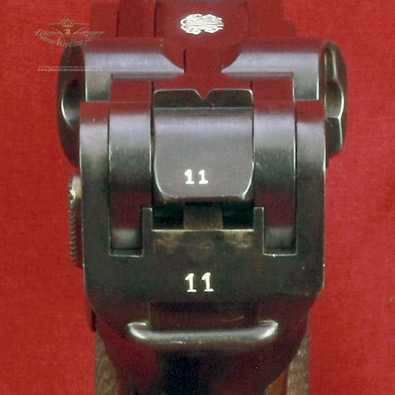 |
| The intertwined GL on the back of the 2nd toggle is the reported tell-tale sign that Georg Luger personally worked on or handled this particular Parabellum. Coveted by collectors the world over, having on GL in your collection brings you into a small group of people. Above right: There is an absence of markings which later distinguished the 1900 production model as proofs were added. | |
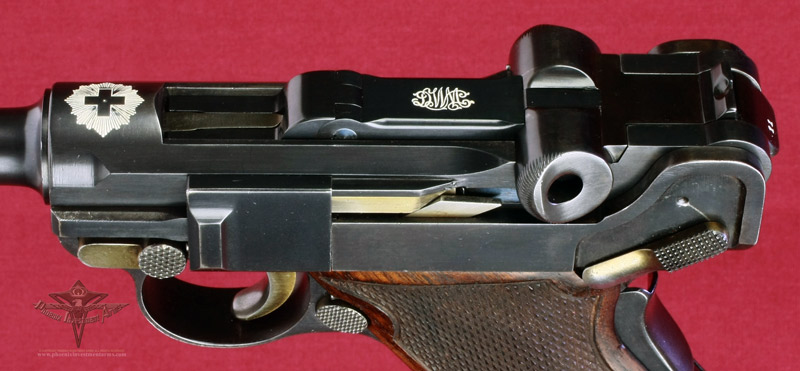
|
|
|
Without written ledgers or time identifications we can only study the remaining pieces of these Transitional Parabellums by observation noting the characteristics of the development of the guns. The Swiss Trials of 1899 brought forth the Parabellum in its first public appearance in a latter production configuration. The Swiss identified serial #5 and another unknown serial number as submissions from DWM. This was obviously not the eighth gun manufactured by Georg Luger and number sequences seem to change per event or contract with the first Swiss purchase in 1900 being numbered '01'. |
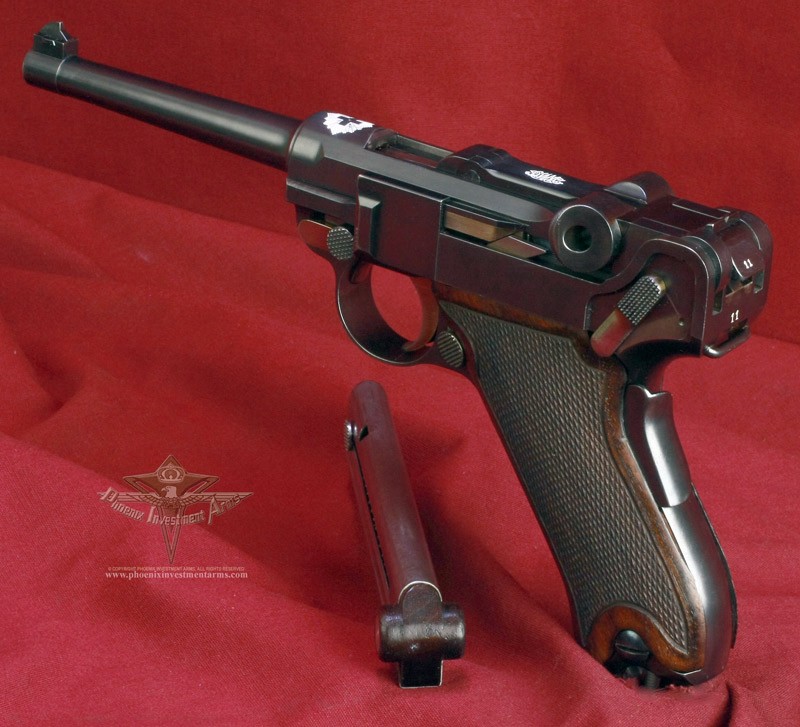
|
|
|
Above you can see the flat button magazine which was used with the early unrelieved frame, the very narrow grip safety, the un-reinforced rear site and the absence of any stock lug. |
|
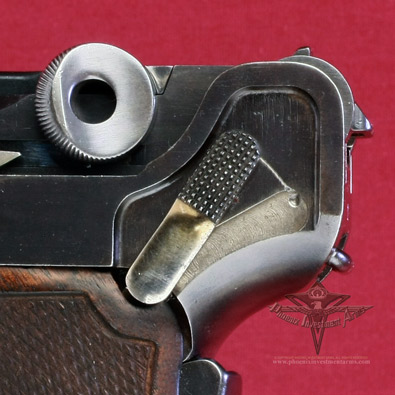
|
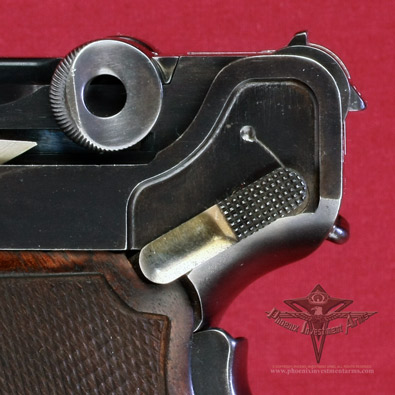
|
| Type I thumb safety does not have the mortised position for the thumb safety or what was referred to early in the development of the Parabellum as safety lock. The early marking did not leave any swirl marks in the "ears" of the frame, (also cited in the Swiss 2nd pattern), and contributed to these early guns that have a beauty of their own. | |
 |
|
|
Above we have the serial number applied to the rear toggle (underside), the stop lug and the barrel. To help evaluate the time this #8 Parabellum was created we have introduced pictures of the frame from a "B" Parabellum (not for sale). These were prototype guns after the during the start of 1900 production. These were mostly GL marked prototypes under the direct supervision of Georg Luger. Below left we have the front grip strap of #8 the 1898 Transitional with a straight solid production. Below Right is Serial 10011B with the production reduction in the front grip strap. |
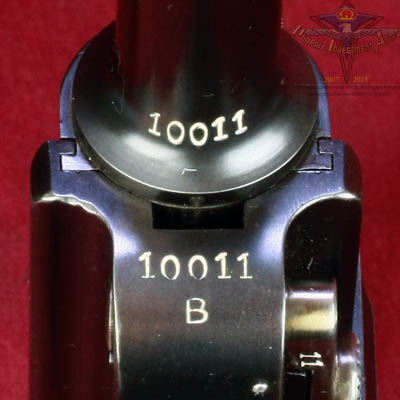
|
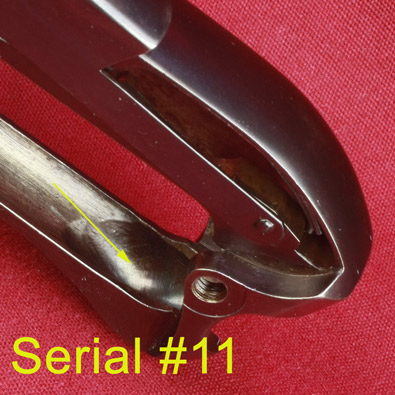 |
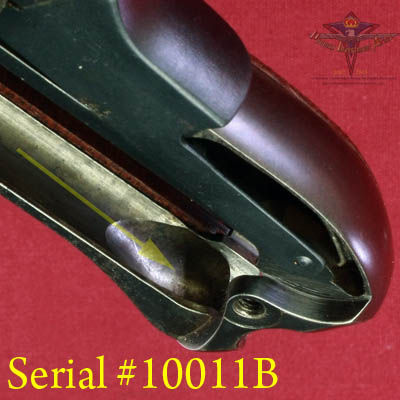 |
|
|
|
|
|
 |
| The serial number of the gun appears on the front of the gun, the bottom of the barrel and side plated. The magazine is an unrelieved magazine with no proofs and the early wood bottom before the Swiss adopted the plates in the bottoms. | |
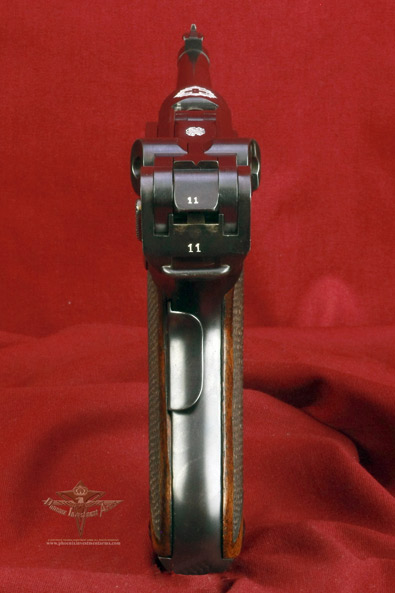
|
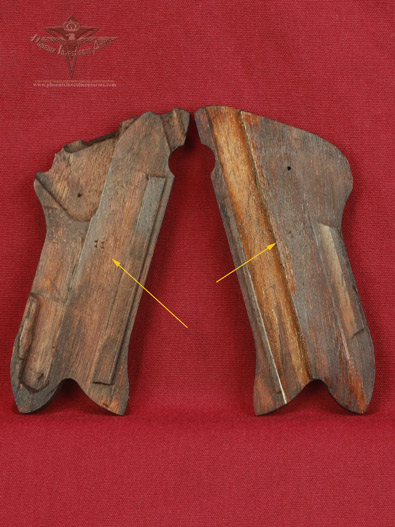
|
|
The first Swiss Trial in 1898 referred to Luger's submission without the grip safety, yet the records show Serial #5 having the small grip safety and the patent drawings from the Novembers 24-25 trials show these changes. The original grips were hinged at the top but for the 1898 test they had been changed to the full length and pinned at the bottom. The grips are hand carved and have the serial number in what was later the conventional location. |
|
|
Following the characteristics of a gun produced during this period (#21) helps us place this gun in the time frame it would have been employed. There is no head stamp, no toggle icon, the toggle hinge is square not rounded, the un-reinforced rear sight leaf, the 1mm longer breach block, the double firing pin (1988 characteristic), major part serial numbers, wide trigger guard, the missing "safety on" (un-blued, in the white) mortised safety employed on later models all examinable on this model placing it clearly before the 1989 test trials. There is no lanyard loop and the dicing on the locking lever and magazine release are the early 45° dicing. |
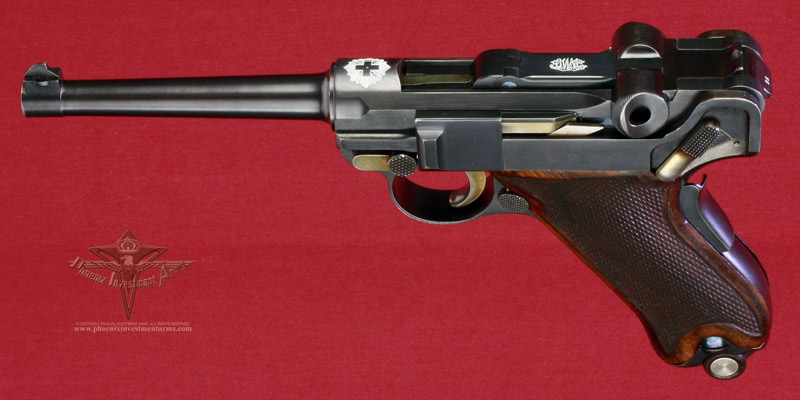
|
|
|
|
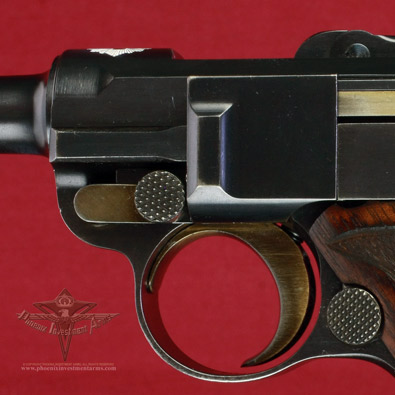 |
|
|
|

|
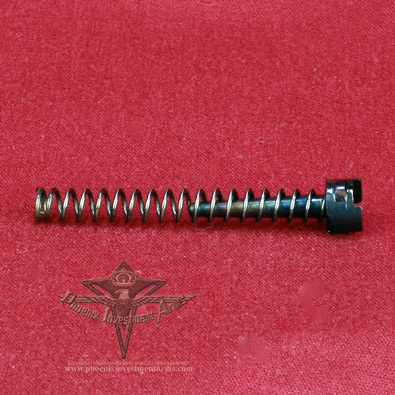
|
|
The 1898 Firing Pin was fire blued and not vented; the design changed by 1900 production standards. Also the 1898 Spring inside the firing pin is shown wrapped around the firing pin retainer. Another indication of the age of this Parabellum. |
|

|
|
| The frame has been machined for the "hold open" which was a characteristic of very early model long frames. Below the toggle lock is pinned on the side and shows the early hatching that was used on the Transitional Parabellum. Below the toggle lock one can see the silver solder holding the latch which doesn't take the blue and is seen as two parallel lines below the toggle lock. | |
|
|
|
The early bordered grips appear in the Swiss Patent drawings #21959. The bordered grips were an early favorite of the Swiss and the extra details of these numbered hand-made grips points us to a presentation model made from this early Transitional Parabellum. Luger's 2nd Swiss Patent in January of 1899 and the US Patent in December 1899 showed the later production grip safety which was delivered in May 1899 to the Swiss for testing. DWM furnished the 1899 Transitional (Type II) to the Swiss in October-November 1899 in a quantity of 20 Parabellums. Writings and examples with Serial numbers 5 & 6 have been studied with the records suggesting that |
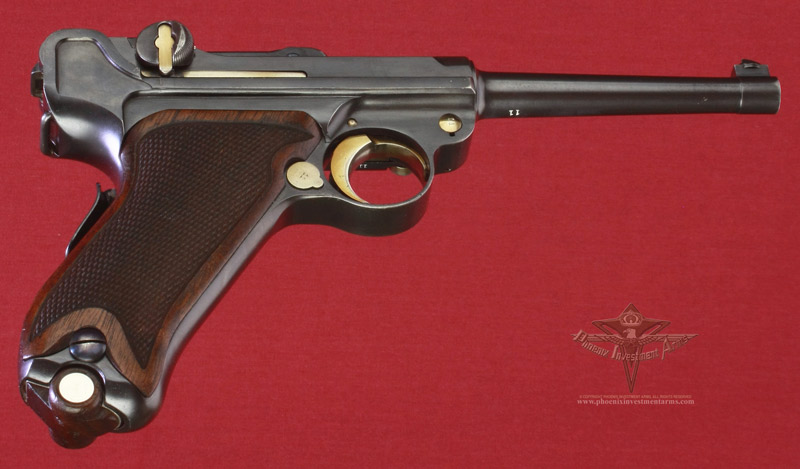 |
|
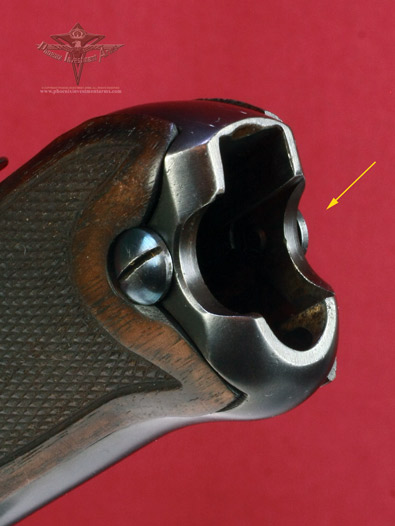 |
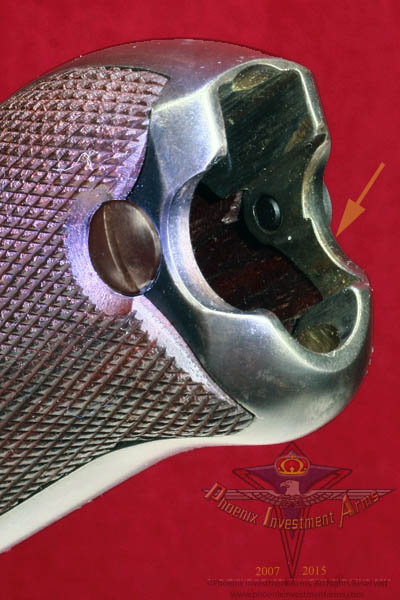 |
| Above Left: The Transitional Serial #8 has an "unrelieved" frame which required a flat magazine follower button. Development of the magazine loading procedure demonstrated that the follower button had to be enhanced to permit use of the loading tool and subsequently the frames were modified by the "relieving" of the metal (shown Serial Number 10011B) at the base of the frame to accommodate a raised button on the magazine. | |
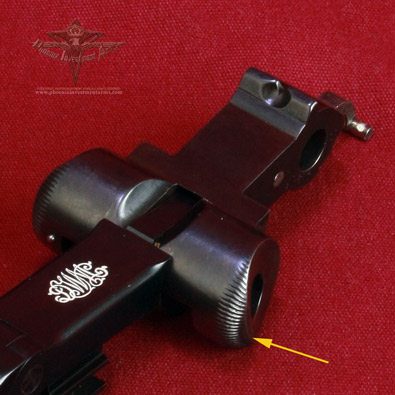 |
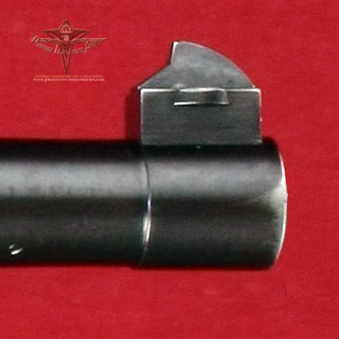 |
|
Above Left: The unique serrations on the dished toggle reveal the early design. At the rear sight mounted on the second toggle there is no reinforcement which was called for as a result of the Swiss Trials. Above Right: The front sight does not have the small hump as found on some of the 1898 models. It is unknown for its purpose and the production model matches those seen and studied. |
|
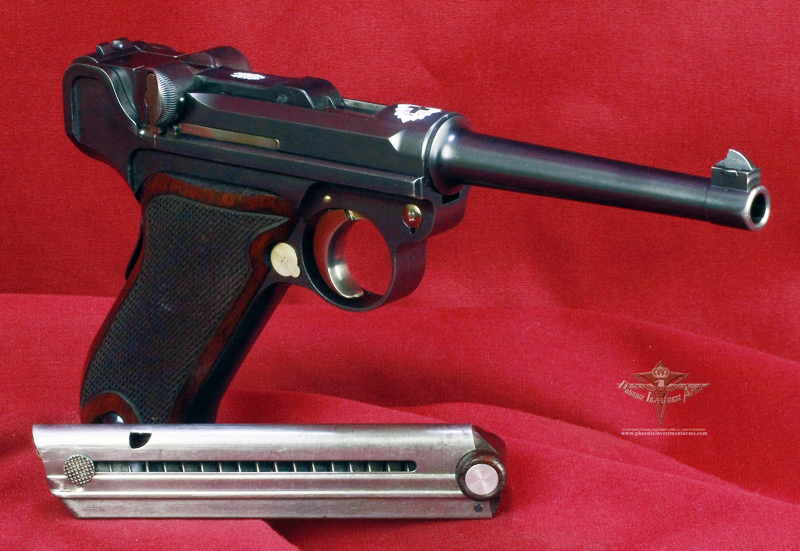
|
|
|
This is an exciting pre-1900 Transitional Presentation gun that was purchased over 35 years ago in Lucerne Switzerland at an International Gun Show and has been in a private collection of a large collector for those many years. Now it is time to provide another custodian to this historical gun. |
|

